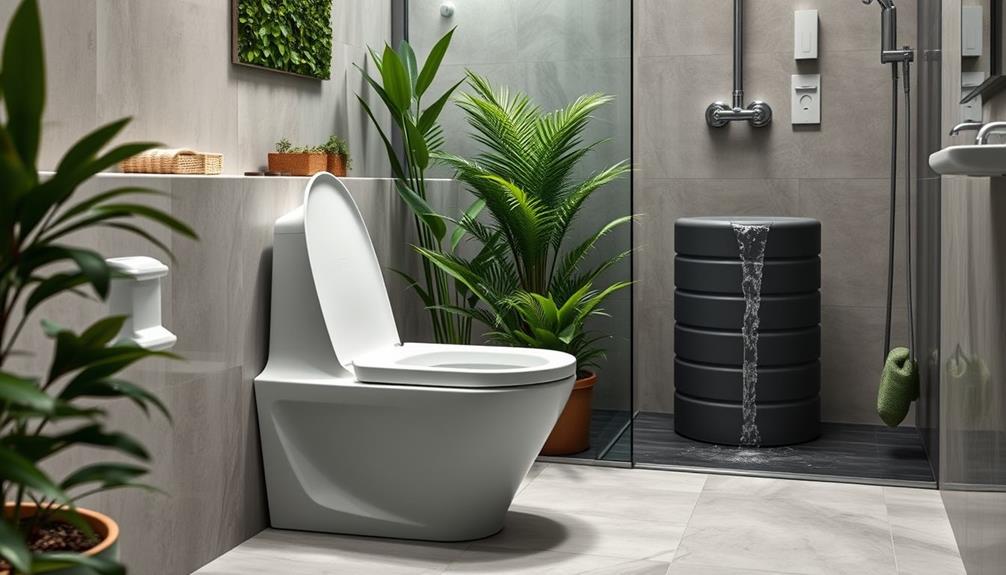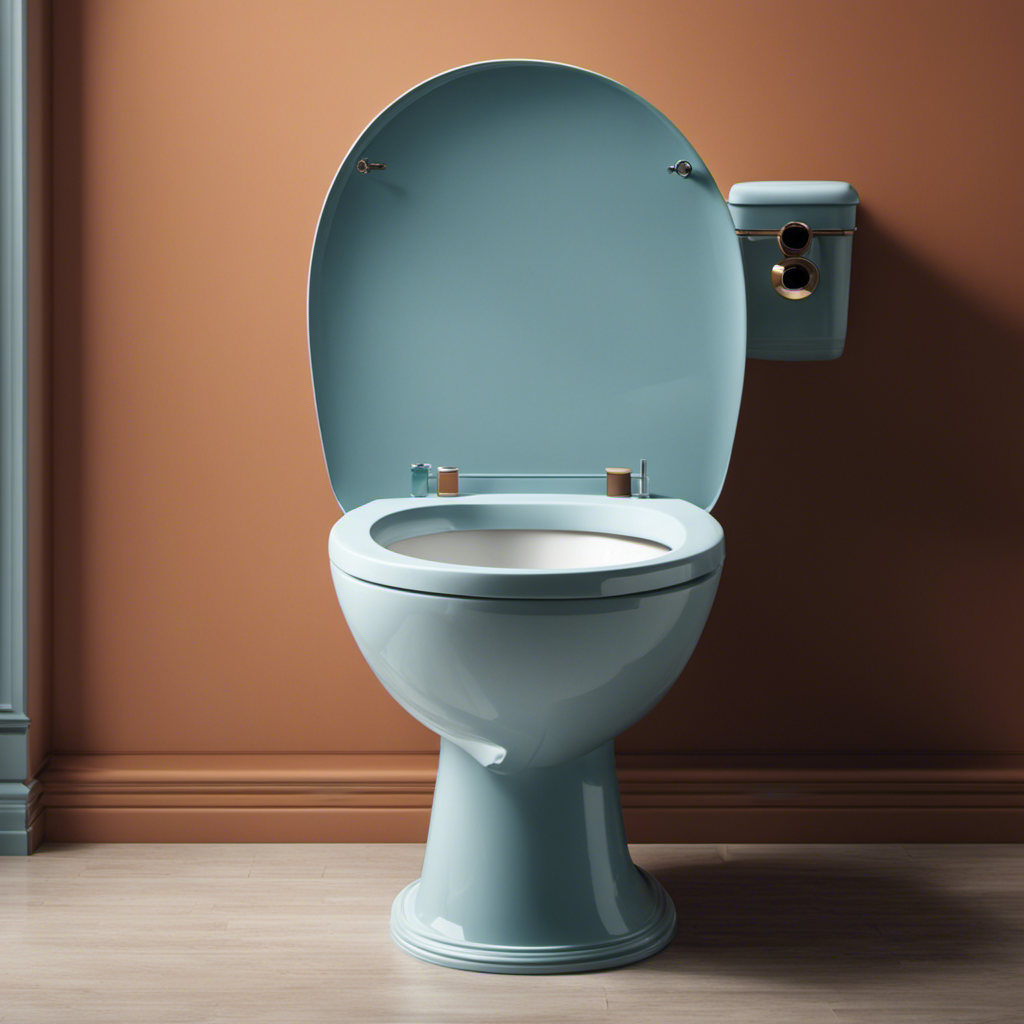Smart toilets greatly improve water conservation and sustainability in your home. They use advanced flushing technology, like dual-flush systems, allowing you to choose between low-volume and high-volume flushes. Many models consume as little as 1.28 gallons per flush—much less than older toilets that use up to 3.5 gallons. Their sensors adjust flushing based on your habits, minimizing waste. Plus, self-cleaning features cut down on water and cleaning product use. By adopting smart toilets, you not only save water but also contribute to broader environmental goals. Curious about what else smart toilets can do? There's more to discover.
Key Takeaways
- Smart toilets utilize dual-flush technology, allowing users to select appropriate water volumes, conserving up to 30% water compared to traditional toilets.
- Advanced sensors adjust flush volumes based on user behavior, significantly reducing water waste in daily usage.
- The integration of IoT technology enables real-time monitoring of water consumption, further optimizing efficiency and conservation efforts.
- Self-cleaning features minimize the need for water-intensive cleaning products, contributing to overall water savings and reducing chemical waste.
- Adoption of smart toilets promotes ecological sustainability, alleviating stress on local water resources and supporting global conservation goals.
Overview of Smart Toilets
Smart toilets represent a remarkable innovation in modern bathroom technology, blending convenience with hygiene. These advanced fixtures utilize sensor technology to automate essential functions, enhancing user comfort while minimizing manual interactions.
With a growing emphasis on health and wellness, these toilets offer health monitoring capabilities, allowing you to gain insights through urine and stool analysis, which can help detect potential health issues early. Additionally, understanding toilet anatomy aids in effective repairs, further emphasizing the importance of maintaining these high-tech installations.
Water conservation is a standout feature of smart toilets, as they optimize flush volumes based on your usage patterns. This capability considerably reduces water consumption, aligning with the principles of environmental sustainability.
The integration of AI and customizable settings, introduced in 2023, further enhances user convenience, allowing you to tailor your experience to fit your preferences.
As the market for smart toilets is projected to exceed $5 billion by 2026, driven by advancements in technology and consumer demand, it's clear that these innovations are reshaping how we think about bathroom solutions.
Investing in smart toilets not only elevates your personal experience but also contributes to a more sustainable future by reducing water consumption and promoting responsible usage.
Water Efficiency Features
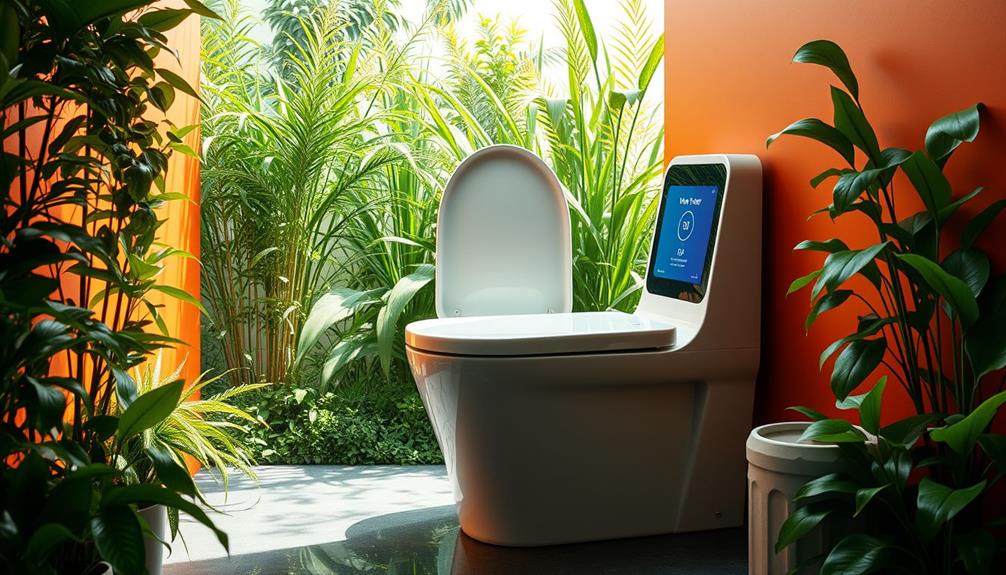
With their focus on convenience and health, smart toilets also excel in water efficiency features that markedly reduce consumption. These innovative fixtures often incorporate dual-flush technology, letting you choose between a low-volume flush for liquid waste and a higher-volume flush for solid waste. This significantly cuts down on overall water consumption.
The advanced flushing mechanisms in smart toilets are engineered to optimize water usage, effectively clearing waste while using minimal water compared to traditional models. Well-draining soil is essential for maintaining the health of other systems in your home, paralleling how smart toilets maintain efficiency.
Many smart toilets utilize sensors to adjust flushing volumes based on user behavior, ensuring water is used only when necessary. This prevents excess waste and enhances water efficiency. Some models can use as little as 1.28 gallons per flush, while older toilets may consume up to 3.5 gallons or more, showcasing a considerable difference in water consumption.
Additionally, by integrating IoT technology, smart toilets provide real-time monitoring and data analysis of your water usage. This helps you identify habits that can lead to further water conservation efforts.
Embracing smart toilets not only enhances your bathroom experience but also contributes to environmental sustainability through reduced water consumption.
Environmental Benefits
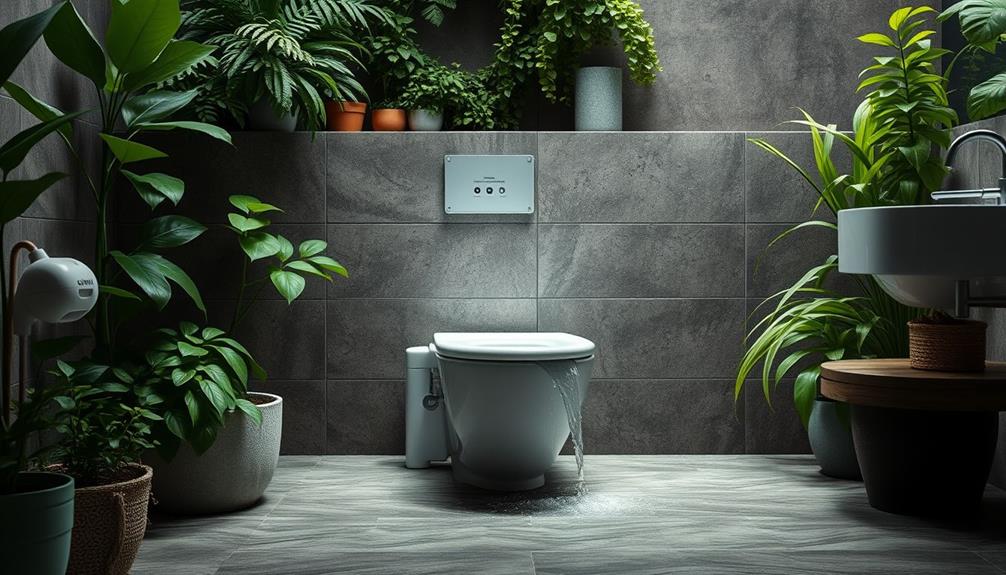
The environmental benefits of smart toilets extend far beyond mere convenience, directly addressing critical water conservation issues. By utilizing advanced flushing mechanisms and dual-flush technology, smart toilets considerably reduce water consumption, using as little as 1.28 gallons per flush compared to traditional models that may waste up to 3.5 gallons. This optimization promotes water conservation, potentially saving your household thousands of gallons annually.
In addition, similar to the efficiency improvements seen in larger wind turbines that produce more electricity, smart toilets exemplify how technology can lead to better resource management.
Additionally, the self-cleaning capabilities and touchless operation of smart toilets lead to a substantial reduction in toilet paper use. This not only lessens paper waste but also minimizes your environmental footprint.
With their low-flow rates and high-efficiency capabilities, smart toilets align with global sustainability goals, aiding in certifications like LEED for green buildings.
The adoption of smart toilet technology contributes to reducing overall water usage, alleviating stress on local water resources. This shift toward eco-friendly options promotes long-term ecological sustainability.
Innovations in Technology
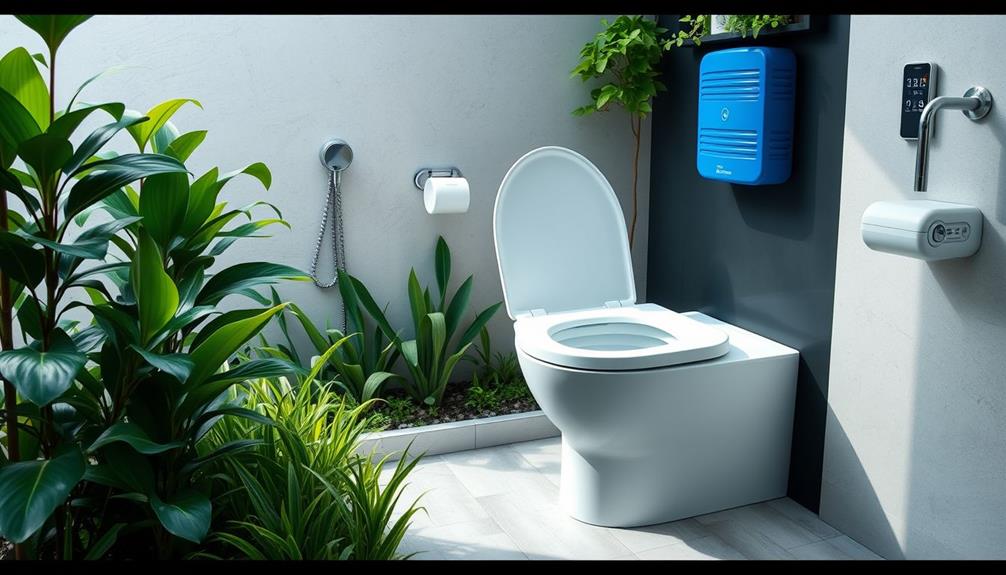
In recent years, innovations in toilet technology have transformed how we think about bathroom hygiene and water usage. Smart toilets utilize advanced features like dual-flush technology, allowing you to choose between different water volumes for liquid and solid waste. This greatly cuts down on overall water consumption.
With the integration of IoT platforms, you can remotely access and control your toilet via smartphone, enabling real-time monitoring and optimization of water usage for enhanced conservation efforts. Furthermore, the adoption of such technologies aligns with sustainable practices promoted through AI-driven insights for conservation.
Many smart toilets come equipped with self-cleaning mechanisms that maintain hygiene while reducing the need for water-intensive cleaning products, promoting environmental sustainability. Additionally, the incorporation of AI and machine learning allows for predictive analytics, optimizing flush volumes based on your behavior. This minimizes unnecessary water usage without sacrificing performance.
Market Trends and Adoption
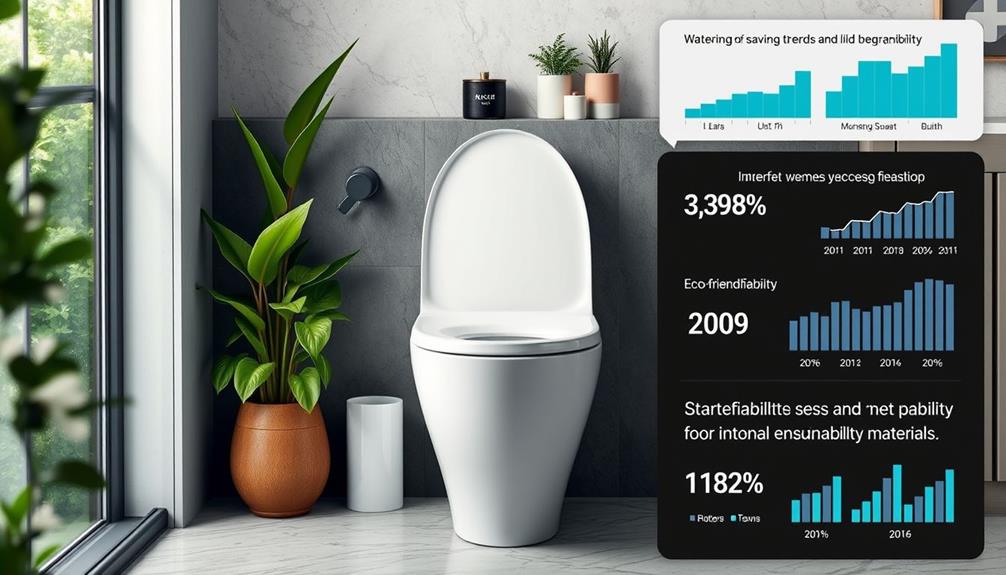
As urbanization continues to rise, you're likely noticing an increased demand for smart toilets that fit seamlessly into modern homes.
These advanced fixtures not only enhance your bathroom experience but also integrate with smart home systems for improved efficiency.
With growing awareness of sustainability, adopting smart toilets is becoming a practical choice for eco-conscious consumers like you.
Additionally, much like the shift towards healthier food choices, the move towards smart toilets reflects a broader demand for products that minimize environmental impact.
This trend aligns with the rising interest in water conservation, as these toilets often utilize less water than traditional options.
Rising Urbanization Demand
Amid rising urbanization, smart toilets are experiencing a surge in demand, reflecting a considerable shift in consumer preferences. As urban populations grow, you'll find that these innovative toilets aren't just a luxury but a necessity for modern living.
This trend aligns with the growing focus on healthy lifestyle blogs that emphasize sustainable living practices. Here's why:
- Water Conservation: Smart toilets optimize flush volumes based on usage patterns, considerably reducing water consumption.
- Health Monitoring: With built-in health monitoring features, these toilets address hygiene and wellness, catering to health-conscious individuals.
- Luxury Bathroom Upgrades: As disposable incomes rise, consumers are increasingly investing in luxury smart bathroom upgrades that enhance comfort and environmental sustainability.
- IoT Platforms: Smart toilets' integration with IoT platforms allows for remote control via smartphones, appealing to tech-savvy urban dwellers seeking convenience.
With a projected market growth exceeding $5 billion by 2026 and a CAGR of over 15%, it's clear that smart toilets are becoming essential in urban settings.
Their ability to contribute to environmental sustainability while providing modern conveniences makes them a smart choice for anyone looking to embrace the future of bathroom technology.
Smart Home Integration
Smart toilets are becoming a cornerstone of modern smart home integration, reflecting a significant shift in consumer behavior and preferences. With a projected market growth exceeding $5 billion by 2026, it's clear that consumer demand for luxury bathroom upgrades is on the rise.
As urbanization increases and disposable incomes grow, homeowners are turning to smart home technologies, including water-efficient smart toilets, to enhance their living spaces. Many users report success with best websites to earn money online by pursuing freelance opportunities that allow them to invest in such upgrades.
These innovative toilets incorporate integrated sensors and automated features that help in reducing water consumption while promoting environmental sustainability. Health-conscious consumers are particularly drawn to their self-cleaning capabilities and health insights, which not only promote hygiene but also optimize flush volumes for effective water conservation.
The collaboration between tech firms and manufacturers is accelerating the adoption of these smart technologies in plumbing systems, making it easier for you to manage water usage remotely.
As you embrace these advancements, you contribute to more efficient water management practices in your home. By choosing smart toilets, you're not just investing in a luxury upgrade; you're making a conscious choice towards a more sustainable future.
Future of Sustainable Toilets
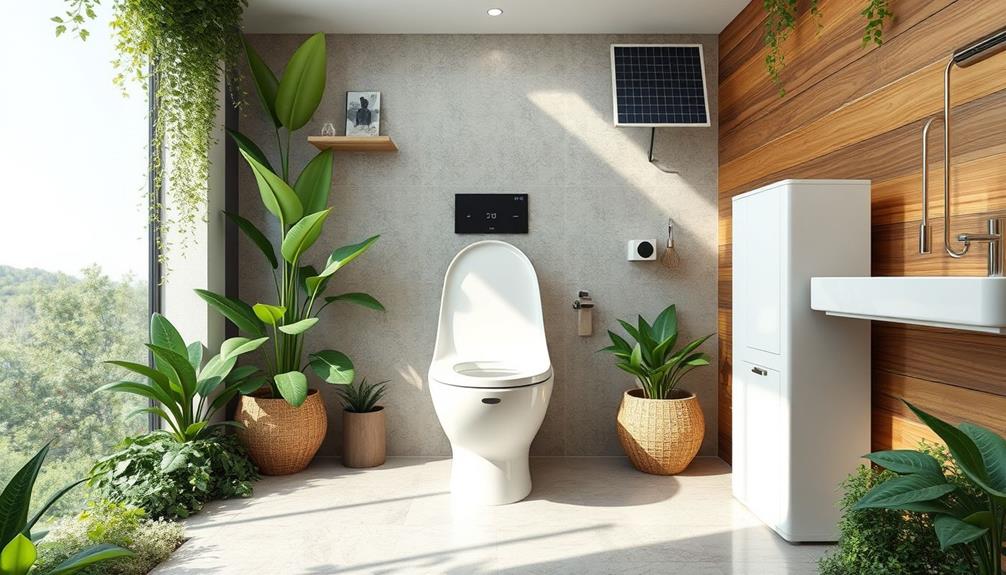
Many people are looking toward the future of sustainable toilets with optimism, as advancements in technology promise significant improvements in water efficiency and eco-friendliness.
As you consider adopting these innovations, you'll want to focus on several key features that enhance water conservation and support environmental sustainability. Incorporating smart solutions, much like those found in high-altitude hiking strategies, can also lead to more efficient resource usage in daily life.
- Dual-flush mechanisms: These enable you to choose between a lower volume flush for liquid waste and a higher volume for solid waste, effectively reducing water usage.
- Smart toilets: By integrating AI and machine learning, these toilets optimize flushing based on your habits, potentially cutting overall water consumption by up to 30%.
- Eco-friendly materials: Manufacturers are increasingly using sustainable materials, minimizing the ecological footprint of toilet production and disposal.
- Water-efficient designs: These designs can lead to a collective reduction of millions of gallons of water annually as more households switch to smart, water-saving solutions.
With these technological innovations driving a shift towards sustainable living, you can play a role in conserving resources for future generations.
Frequently Asked Questions
How Do Toilets Affect the Environment?
Toilets considerably impact the environment by consuming large amounts of water. You can minimize this effect by choosing efficient models, reducing waste, and adopting practices that lower your household's overall water usage and environmental footprint.
What Are the Benefits of a Smart Toilet?
Ever wondered how a toilet can enhance your daily routine? With features like dual-flush systems, self-cleaning, and health monitoring, smart toilets save water, improve hygiene, and promote better health—all while adding convenience to your life.
How Can Toilets Be Sustainable?
You can make toilets sustainable by choosing water-efficient models, utilizing dual-flush systems, and incorporating self-cleaning features. These choices minimize water waste, reduce chemical use, and contribute to a healthier environment for everyone.
Do New Toilets Save Water?
Yes, new toilets save water. They use dual-flush options, optimize flush volumes, and feature low-flow designs. By upgrading, you'll reduce your water usage, lower your bills, and contribute to a more sustainable future.
Conclusion
In the grand tapestry of sustainability, smart toilets represent a crucial thread weaving water conservation into our daily lives. By embracing their innovative features, you're not just upgrading your bathroom; you're nurturing the planet. Each flush symbolizes a step towards a greener future, where efficiency meets responsibility. As these technologies evolve, they hold the promise of transforming our homes into sanctuaries of sustainability, reminding us that even the smallest changes can ripple through the environment, creating lasting impact.
